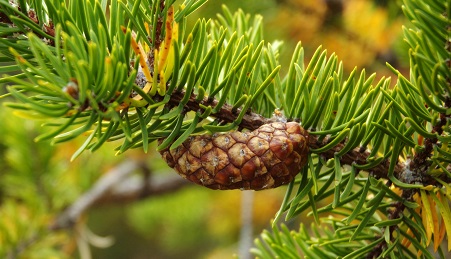A Plant Community Built on Sand and Renewed by Fire.
What Makes a Pine-Oak Woodland Unique?
The pine-oak woodland is an uncommon plant community found on sandy valley floors near streams and rivers of southeast Minnesota. The soil is well-drained due to eroding sandstone cliffs found in this community and streams depositing sandy soil as they flow towards the Mississippi River. The canopy is usually dominated by pines and oaks, with the occasional basswood and cedar. Tree species in Como Woodland Outdoor Classroom’s pine-oak woodland include white pine, jack pine, red oak, and basswood.
The presence of conifers like pines and cedars sets this plant community apart from others represented in the Classroom. Most coniferous trees keep their green needles year round. Conifers do shed their needles, but most do not shed them all at one time like a deciduous tree. Needles are typically kept two to three years before they are shed.
Because they grow on well-drained sandy soil, pine-oak woodlands are dry. They are also fire-dependent plant communities. According to Public Land Survey records, catastrophic fires occurred approximately every 135 years, with mild surface fires about every 15 years.
A unique plant species found in pine-oak woodland is the bracken fern. This fern can be identified by its single stem that emerges from the ground and splits into three parts. Also, in the spring or early summer, look for the delicate white flowers of Clayton’s sweet cicely or the showy purple/pink flowers of wild geranium.
Species Spotlight: Jack Pine

Jack pine (Pinus banksiana) provides an excellent example of a tree that thrives in a fire-dependent woodland. Jack pine seeds are locked inside pine cones sealed with resin that only melts when exposed to high temperatures. When woodland fires occur, the seeds are released by the heat, allowing the jack pine to recolonize the newly burned, fertile woodland floor. Not only do jack pines need fire to open their cones, the seedlings also need full sun to grow. Fire also helps open the canopy, allowing the seedlings to receive direct sunlight.

